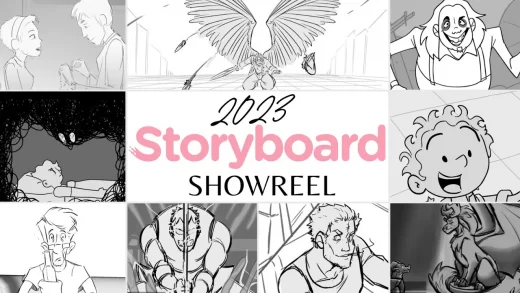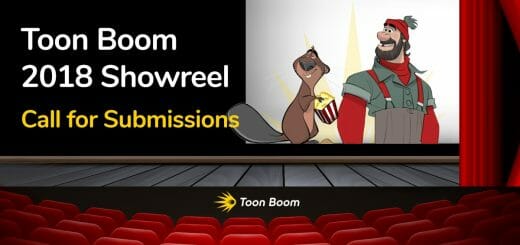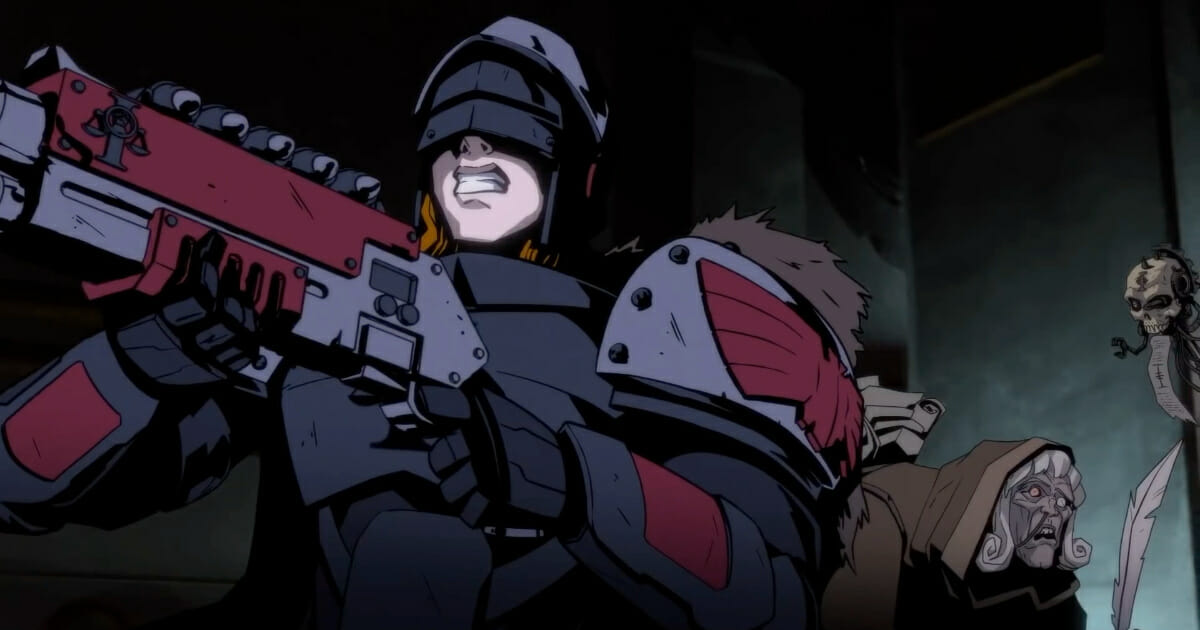
“The boltgun is far more than a weapon; it is an instrument of Mankind’s divinity, the bringer of death to his foes. Its howling blast is a prayer to the gods of battle.“
— Roboute Guilliman in The Apocrypha of Skaros
The Bolter, or Boltgun, will be familiar to fans of Games Workshop’s Warhammer 40,000. The iconic weapon is a mainstay of the beloved tabletop game and the universe of books, movies and animation that it has inspired. The newest addition to this anthology is a clandestine caper that takes place in the “dark corners of The Imperium,” a vast galaxy-spanning empire in which 40K is set. Hammer & Bolter: Death’s Hand, by Bristol-based animation studio Sun & Moon, has certainly got fans of the franchise talking.
For the series, Sun & Moon have taken the gothic science-fiction of the 40K world and put a uniquely Anime spin on it. The dark atmospheres and violent scenes of Games Workshop’s original art style lends itself to the medium perfectly. Those versed in the lore may recognize some high-powered character classes on display in the trailer, such as the Inquisitor and elite Catachan Commandos. The action-packed teaser hints at brutal melee, surreptitious stealth and ruthless ranged combat. It wouldn’t be Warhammer without it.
We caught up with Dylan Shipley and Nia Alavezos from Sun & Moon to talk about Death’s Hand. We discuss how they rendered the dark, doom-laden Warhammer 40,000 world so faithfully, and the ways they make it’s heroes and villains feel authentic. They also share news of more Warhammer anime coming in the future. You can watch the trailer for Hammer and Bolter and read our interview below:
Hi! Can you introduce yourself and tell us about Sun & Moon Studios?
Hi there, I’m Dylan Shipley, co founder and animation director here at Sun & Moon. We’re an award-winning and creative-led animation production studio based in Bristol U.K, known for producing high-quality animation that’s packed with character.
Hammer & Bolter: Death’s Hand gives the anime treatment to Warhammer 40K. What was it like putting this project together?
It’s a really fantastic project to be working on. I’ve been an avid player and follower of Games Workshop’s games and stories since I was a child so it’s been a dream come true to have been able to work on animation for them. I’m also a huge fan of anime so it’s amazing to be able to bring these two worlds together.
The style of animation is a slight departure from Games Workshop’s original art style. How did you bring this story into an anime world while remaining faithful to the style of original lore?
I’d say a lot of anime is actually not that far away from Games Workshop’s art style. Certain types of anime, especially those from the 90’s OVA era, share a great deal in terms of the grim dark oppressive atmosphere and violence, so it didn’t feel that difficult. The biggest challenge was making sure we remained faithful to the detailed designs of each weapon, type of armour, etc. The Warhammer 40,000 world Games Workshop has created is very deep and specific, so we needed to make sure we got the design of every type of gun, icon or clothing style correct and faithful to their universe. We also had to push ourselves hard to maintain the very dark style 40K portrays; all human characters are worn down by the Imperium, they have bags under their eyes, everything is dark, heavy and oppressive. It’s what I find unique and refreshing about 40K: Pushing that dark atmosphere to the extreme.
We’ve seen video-game adaptations in anime become popular, but being an adaptation of a table-top game, Death’s Hand is slightly different. What unique challenges did you face in the adaptation?
The tabletop game is very much like a video game but when we play with the models, we actually feel the static miniatures moving and fighting in our imaginations. Our challenge was to add in the extras: What does a particular type of armour sound like? How can this conversion field energy shield in the tabletop game, which shields an attack on a dice roll dice of 4+, be shown faithfully in a fight, in animation? We discovered how it sometimes works and sometimes doesn’t in the original game.
The trailer features iconic heroes from the 40K universe. What details did you consider when designing the characters?
We worked closely with the team at Games Workshop to make sure each character looked authentic to their own backgrounds; and also considered shape language. We have two Inquisitor characters in the episode but one is very much made of square shapes, the other more triangular. The miniatures are also very detailed and often made of hard edge armour, so we worked out ways to combine the CG with 2D animation. We’ve also used Master Controllers a lot to help us bring complicated objects such as weapons into the 2D Toon Boom environment.
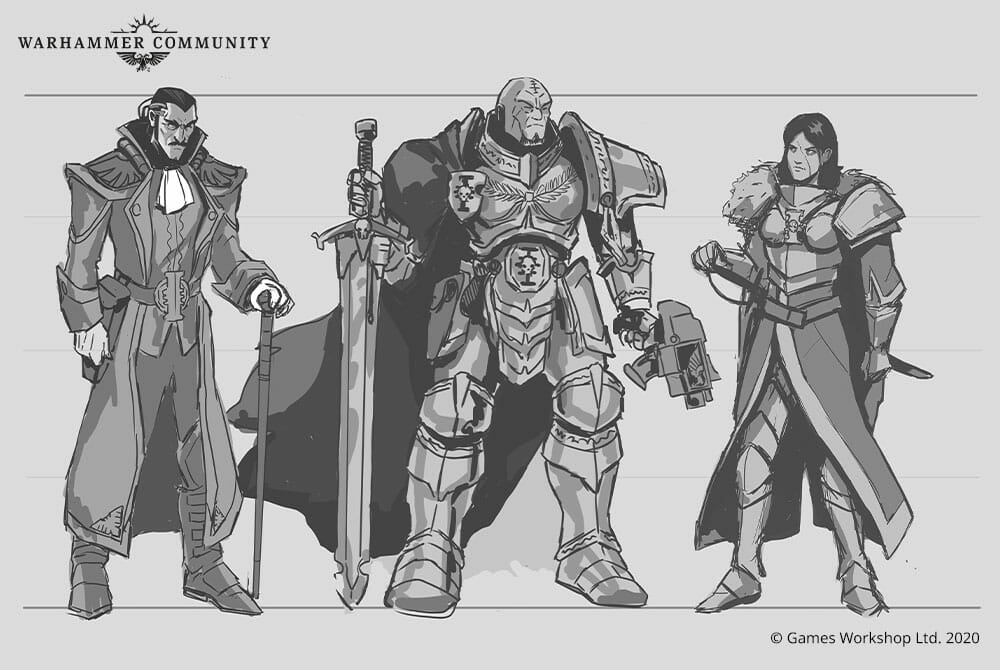
What was the approach when storyboarding the project?
We boarded the scripts Games Workshop wrote. I worked closely with the storyboard artists here and due to COVID restrictions, we’re all working remotely, so I send photos of thumbnails sketched on paper which are then translated into Storyboard Pro. We then work back and forth refining the storyboards down before submitting to Games Workshop for further refinements.
Being part of the Warhammer franchise, we’re expecting a lot of fighting and fantasy violence. What was the process to bring this action to life?
A lot of Warhammer 40,000 is about battle and violence, so we have a lot of action scenes and have thought hard to create very dynamic fighting with a lot of movement. There is a lot more action here than the usual anime which often resorts to long scenes of dialogue. We’ve found a good way of storyboarding these scenes and have paid homage to a lot of the classic OVA anime which I’m personally very happy about. I’d love to be able to bring back some of the brutal anime of the ’90s and this is something we’re marrying into the 40K universe with what I think are great results.
Were there any tools or techniques that proved especially useful on the project?
The integration between Storyboard Pro and Toon Boom Harmony was very useful. At the press of a button we are able to export individual animatic shots with all camera moves, sound, layout images, and background files, which is both quick and accurate. We also have made good use of master controllers in being able to rotate and manipulate complex 3D objects.
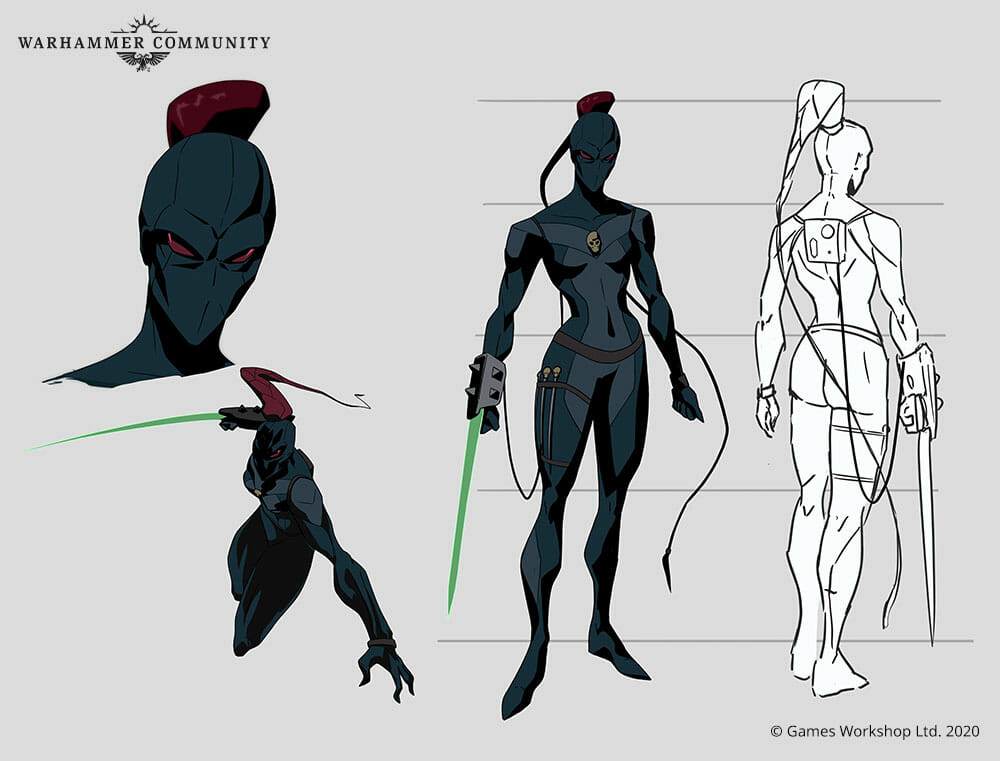
Which of your team members looked after which parts of the process?
Nia Alavezos is the overall Senior Production Coordinator and we work very closely together keeping everything running smoothly. I’m Series Director so looking at the overall episode but concentrating day-to-day on directing animatics, design, and looking heavily at the final comp. Lindsay Holyoak is the overall Producer. Ryan Neal is Assistant Director here feeding back on animation, clean-up, colour, and background art. Owen Simons is our CG lead heading the team of CG modellers and animators, Owen also handles all of the Master Controller setup.
Is there anything coming up for Sun & Moon that you can share with our readers?
We have lots of exciting projects in the pipeline, including some more projects with Games Workshop, so expect to see more than just one episode of Death’s Hand. We are working on even more episodes for them in Hammer and Bolter and also Interrogator, a gritty Noir-styled animated series set in the 40K Universe!
Death’s Hand is the first episode in the Hammer & Bolter animated anthology series, with a second episode, A Question of Faith, already announced. See more award-winning work from Sun and Moon at their website.


